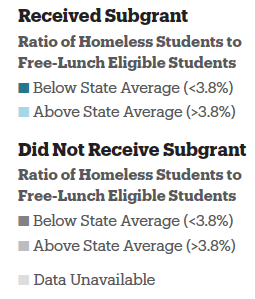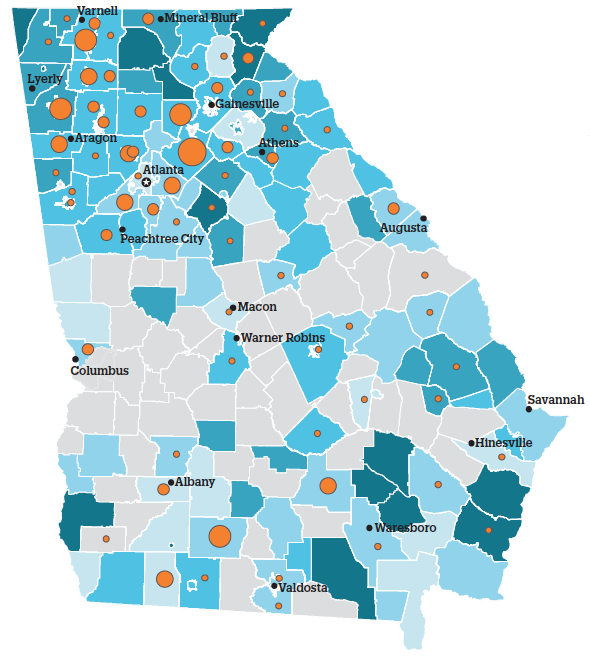Student Homelessness Snapshot
November 2016
This snapshot is part of a series analyzing student homelessness in all 50 states and the District of Columbia. Visit www.ICPHusa.org for more information.
- In the 2013–14 school year, Georgia had 1,723,909 students enrolled in 198 local education agencies (school districts) representing the state’s 159 counties and other agencies.1
- That year, there were 36,845 homeless students in the state, making up 2.1% of total enrollment.
- Georgia had the 7th highest number of homeless students and the 28th highest rate of student homelessness in the U.S.
- School districts with the highest rates of student homelessness were Hancock County (32%) and Fannin County (16%).
Figure 1
Number of Homeless Students and Percent Living Doubled-Up2
By School District, SY 2013–14
In its definition of homelessness, ED includes students in shelter as well as those with no option but to stay with others in overcrowded, often unsafe living conditions.



Source: U.S. Department of Education. “Homeless Student Enrollment Data by Local Educational Agency: School Year 2013-14” http://www2.ed.gov/about/inits/ed/edfacts/datafiles/school-status-data.html.
- Eight school districts had over 1,000 homeless students (Atlanta Public Schools, Gwinnett, DeKalb, Fulton, Muscogee, Clayton, Cobb, and Polk counties). Seven school districts had rates of student homelessness above 10%.
- In 28 school districts, over 93% of homeless students were sleeping in a temporary doubled-up living arrangement. Six school districts had over 1,000 homeless students in doubled-up conditions (Atlanta Public Schools, Gwinnett, DeKalb, Muscogee, Clayton, and Polk counties).
Figure 2
McKinney-Vento Funding and Number of Homeless Students
SY 2011–12 to SY 2013–14
The Education for Homeless Children and Youth program, established by McKinney-Vento, is the primary source of federal funding for homeless students in elementary and secondary school.
- Since SY 2011–12, Georgia’s McKinney-Vento funding increased 3% to $2.3 million. Over the same period, the number of homeless students rose 11%, to 36,845. Georgia had the 27th highest rate of growth in student homelessness nationwide during that time.
- On average, Georgia received $61.47 per homeless student in SY 2013–14, down from $66.40 in SY 2011–12. Nationally, the per-student average for SY 2013–14 was $49.98.

Figure 3
School Districts Receiving McKinney-Vento Subgrants
and Ratio of Homeless Students
to Free-Lunch Eligible Students
By School District, SY 2013–14
Comparing the numbers of homeless and low-income students is a way to gauge how well schools are identifying homeless students.



Source: U.S. Department of Education. “Homeless Student Enrollment Data by Local Educational Agency: School Year 2013-14” http://www2.ed.gov/about/inits/ed/edfacts/data-files/school-status-data.html; National Center for Education Statistics. “Local Education Agency (School District) Universe Survey Data” https://nces.ed.gov/ccd/pubagency.asp.
- In Georgia, 44% of school districts had a ratio of homeless students to free-lunch eligible students smaller than the statewide average (3.8%), including 19 that received subgrants.
- In SY 2013–14, one-quarter of Georgia’s school districts received McKinney-Vento subgrants, and 78% of the state’s homeless students lived in a district with a subgrant. Non-grantees with the most homeless students included Coffee and Fannin counties.
Figure 4
Proficiency in 3rd Grade Reading and Math
SY 2013–14
Student performance in third grade is a strong predictor of high school graduation, and has been shown to be affected by family and socioeconomic factors.
- The achievement gap between districts with high and low rates of homelessness was narrow. Third grade students in areas with above-average student homelessness passed their state assessments at rates only 3-5 percentage points lower than in districts with below-average rates of student homelessness.
- Berrien County had the highest passing rates among districts with above-average homelessness, with 100% of third graders passing reading and 95% of students passing math. Four districts had passing rates below 70% on both tests.

Figure 5
Homeless Students with Disabilities and Homeless Students with Limited English Proficiency
By School District, SY 2013–14
Students with disabilities or limited English proficiency are eligible for additional support services but may have difficulty accessing them if they are homeless.




- In 16 school districts, over 24% of homeless students were identified as having a disability.
- Three school districts have over 100 homeless students with limited English proficiency (Dalton City, Gwinnett County, and Forsyth County). In six school districts over 20% of all homeless students had limited proficiency (Rome City, Dalton City, Calhoun City, Wayne County, Evans County, and Burke County).
Figure 6
Where Homeless Students Live, by Population Density
SY 2013–14
Families in rural areas or small towns often have fewer shelters or services to turn to for assistance.
- In Georgia, 35% of homeless students lived in suburban school districts, including 12,990 students who lived in areas of over a quarter-million people. Among cities, five districts each had over 500 homeless students.
- Homelessness was disproportionately seen in Georgia’s small towns and rural areas. Despite enrolling only 32% of the total student population in the state, these districts accounted for 40% of all homeless students.

Source: U.S. Department of Education. “Homeless Student Enrollment Data by Local Educational Agency: School Year 2013-14” http://www2.ed.gov/about/inits/ed/edfacts/data-files/school-status-data.html; U.S. Department of Education. “NCES Common Core of Data Local Education Agency Universe Survey: School Year 2013–14” https://nces.ed.gov/ccd/pubagency.asp.
Homeless students are too often overlooked by policy-makers when talking about education policy. Improving outcomes and supports for homeless students reduces the burden on teachers, parents, and schools who struggle to help students cope with the trauma of homelessness along with the challenges of poverty.
Questions for educators and state/local legislators to consider:
- Do you know how many homeless children live in your town? In your state?
- Is your school district a McKinney-Vento grantee? How much funding does it receive? How is it used?
- What supports are being provided to help homeless children toward better educational outcomes?
- Are the challenges that homeless students face, such as chronic absenteeism and difficulty traveling to and from school, being addressed?
- Are the educational needs specific to homeless students being identified?
- Does your public school have a dedicated liaison whose priority and focus is the needs of homeless students?
- Do schools coordinate with the shelter system or service delivery system?
- Are homeless students being granted access to services to which they are entitled (e.g. transportation, tutoring, special education, health care, food)?
Data tables for the figures seen here will be available at www.ICPHusa.org starting in January 2017.
Source Notes
